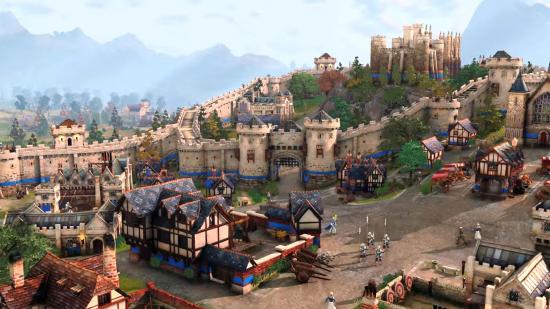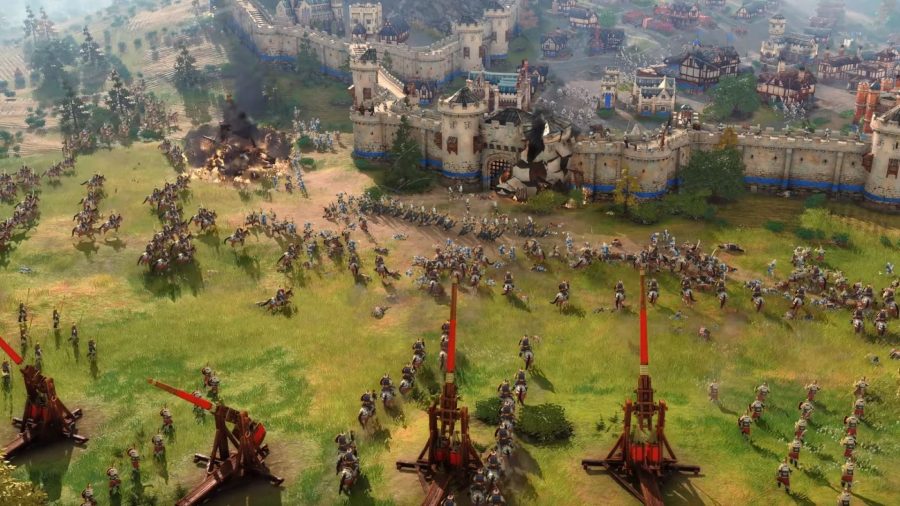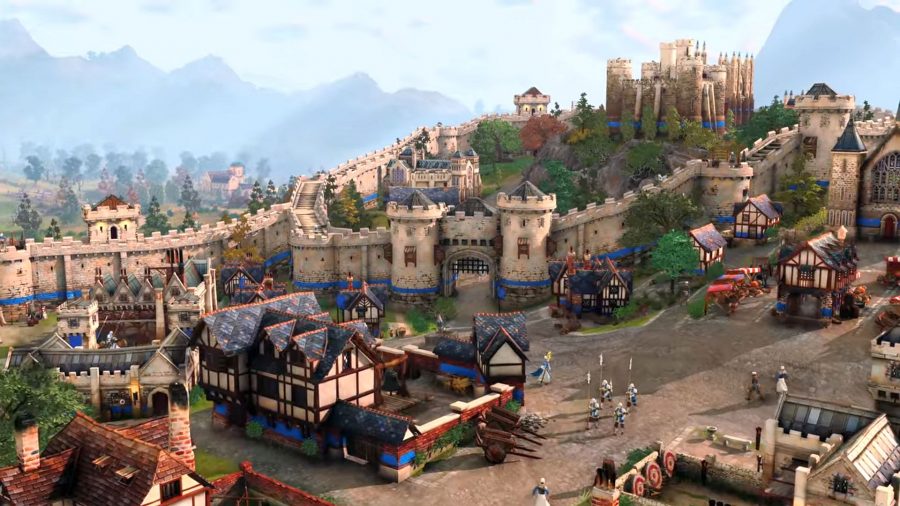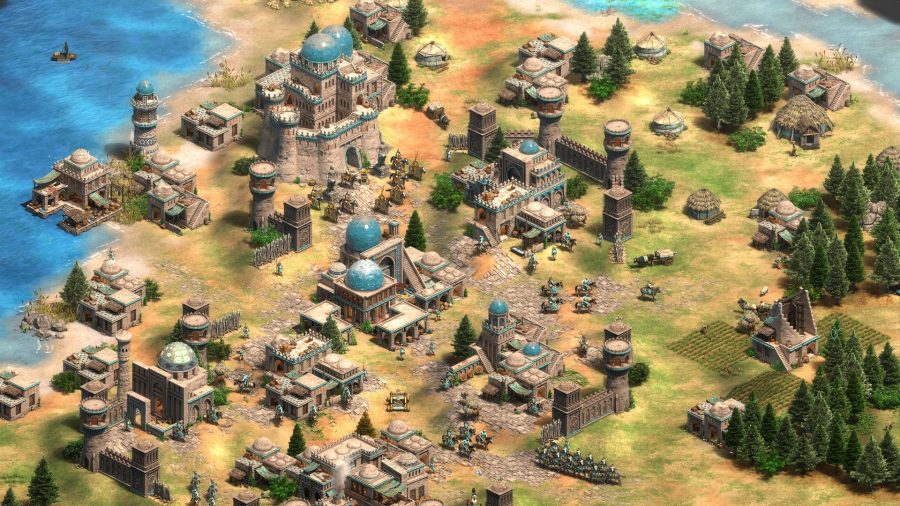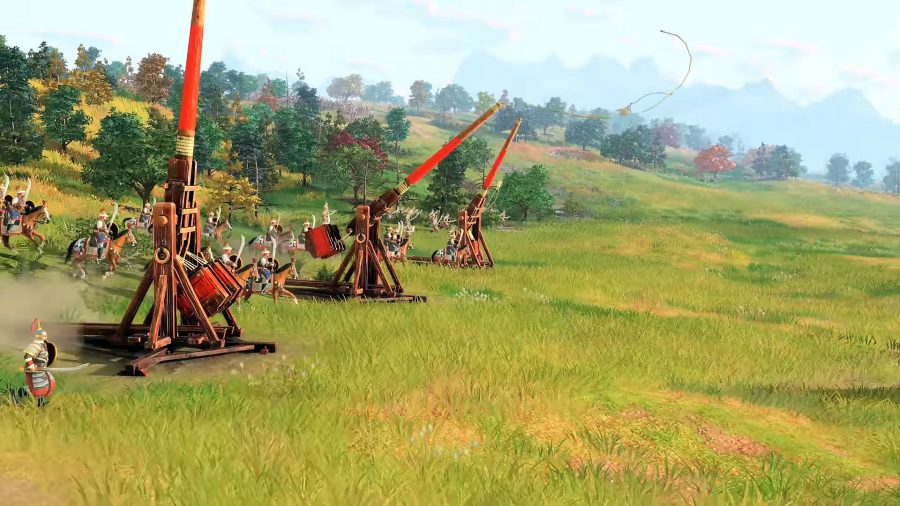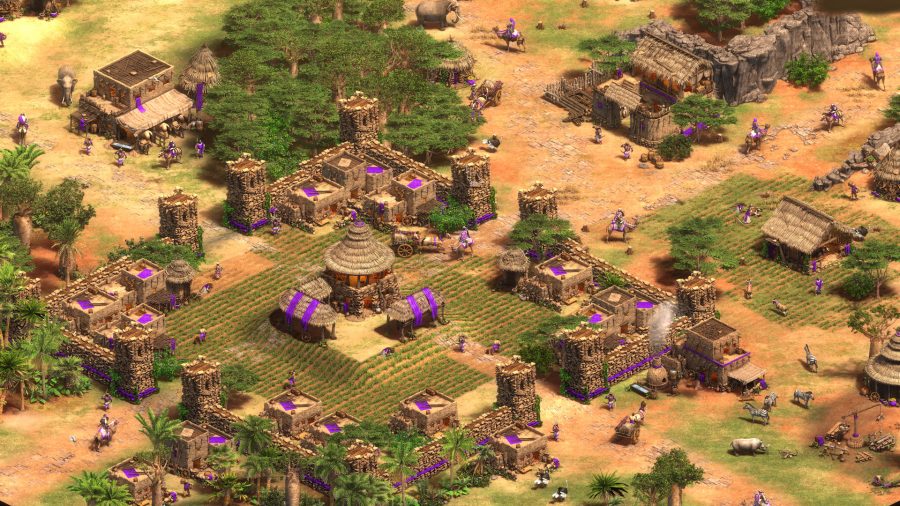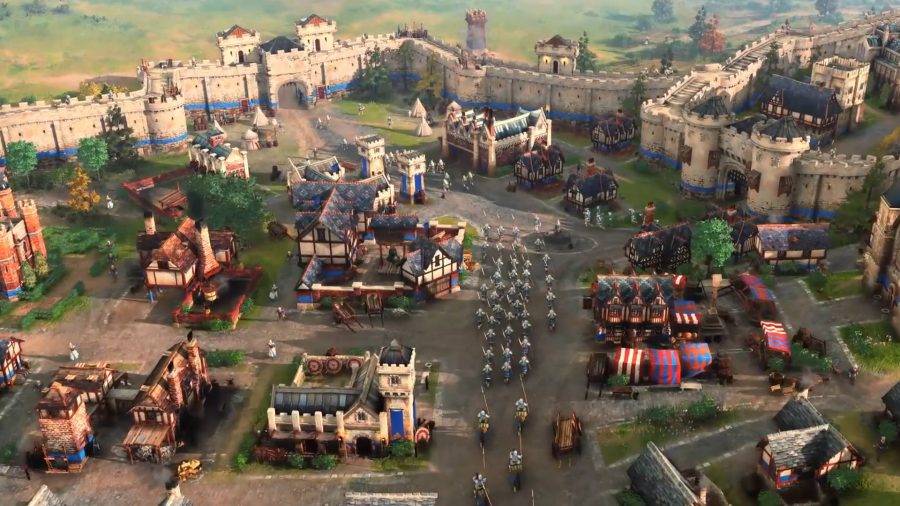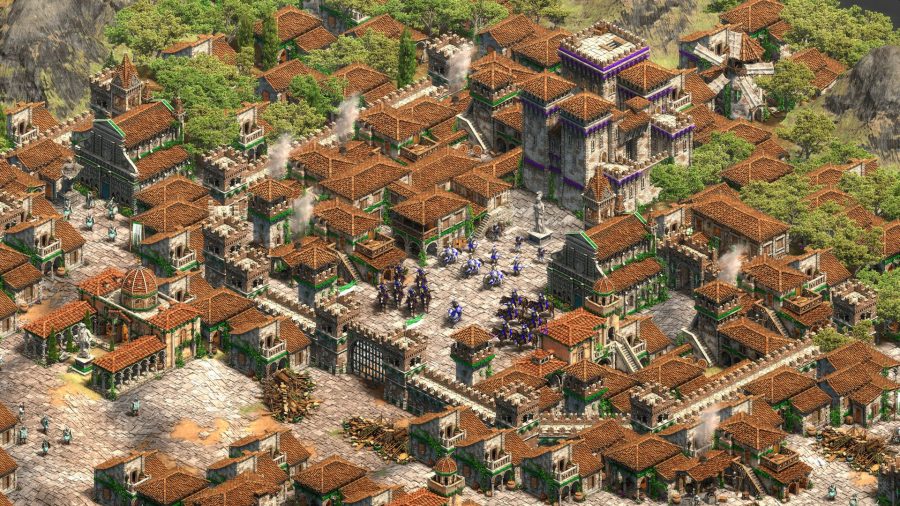Age of Empires IV was first announced at Gamescom 2017 with a 97-second trailer comprised entirely of artwork that, rather teasingly, flitted throughout all the historical periods this iconic RTS series has tackled. And then Microsoft waited more than two years to tell us anything else about it, which was terribly cruel.
But as of X019, we now know Age of Empires IV will return to the Middle Ages – the setting of the series’ most popular instalment, Age of Empires II. At that show we had the chance to speak with Age of Empires creative director Adam Isgreen and Shannon Loftis, head of World’s Edge, the brand new studio Microsoft set up to work on Age of Empires. We also followed up with Isgreen via email on a couple of points, covering everything from crunchy gameplay details about civ design to the inspirations, influences, and challenges behind launching an old-school RTS in 2019.
We’ve stitched together both those interviews into the epic you see below, so pull up your favourite throne, pour yourself a goblet of mead, and put your feet up on your squishiest servant. Here is a very long interview all about Age of Empires IV.
PCGamesN: You’ve said some civs will be familiar to Age veterans while others will diverge dramatically in how they play. This has been a bit of a trend in strategy lately – why do you think that is? Was it something you wanted to consciously imitate?
Adam Isgreen: Really, I think this is more about evolution of thought in terms of what players want today vs what they may have wanted, in the case of Age, 13 or more years ago. Given our commitment to accuracy and detail, it just made a lot more sense for us to push that even further as we explore what a modern take on an Age of Empires game can be.
We have this wide spectrum of civilisations that go from very understandable if you played a previous Age game, to those you really need to learn a lot play them well. While there are certain rules of RTS games in Age that we haven’t changed, we’re exploring many places with this new game to really make the civilisations stand on their own.
Can you give a rough idea of how far you’re taking these divergences? Roughly how many civs will play like old Age of Empires, and how many will differ?
AI: Let’s just say the level of departure grows as you move across the civilisations we offer. The English intentionally play the most like the Britons from Age II; the Mongols are the largest departure from that template. All the others fall in between. Our goal is that the cognitive load (i.e., how many things we want players to have to think about at any given moment) is similar in commitment across the civilisations, but each has a unique focus for where you spend that mental time.
Age II launched with 13 civs. Should we expect more or fewer?
AI: You can expect fewer than the 13 that shipped with Age II, as we’re aiming for more uniqueness with each civilisation rather than quantity.
You’ve talked about the attention to detail you’re applying to civ research. Does each civ have a unique, historically accurate skin for all of its units and buildings?
AI: While we’ve kept specific structures similar in shape language because we want them to be understood across any civilisation that has them, every civilisation in Age IV has unique visuals for every unit and structure in the game, from basic troops all the way up to… whatever may be near the apex of impressive structures.
Most cultures changed fundamentally during the Middle Ages. In Age II this wasn’t really shown – civs were static in their names, bonuses, etc. Will this remain the case in Age IV, or did you want to represent this evolution?
AI: There are aspects of the civilisations that do change across the ages, but at the same time maintaining clearly understood gameplay and balanced cognitive load is very important to us. I can’t go into more detail on this right now, but yes, we’ve thought about this quite a bit!
Can we expect the same familiar design points as in previous Age games? Four Ages to advance through, four key resources to harvest, that sort of thing?
AI: Classically, Age of Empires games deviate a little [from each other], but we really love the model from number two. So yes, there are four resources and all the civilisations use them. Do they use them in the same way? Do they use them in the same order? Hmm, don’t know. You’ll have to find out!
But definitely those are the kinds of quintessential, important things for Age that we felt were worth maintaining. As to your second point, we love the idea of moving through ages. We’ve actually taken it even further in this game – not in terms of the number of ages, although there are civilisations that don’t necessarily play by the four-age rule, I will say that – but there are also new aspects to ageing up, from a presentation point of view, that no one has ever seen an RTS game before.
From the gameplay trailer, the art style is warm, colourful, almost Blizzard-like – fair to say? If so, what was the thinking behind this approach? Is there any blood or gore?
AI: One of the pillars of the Age games has always been ‘a bright, inviting world’ and we certainly mean to maintain that in Age IV. Given the response to the trailer and the look, I think we’re pretty close to where we want to be. Being a PC game, we’ll be sure to include a vibrancy setting if players want to pull the saturation down a bit.
As to blood and gore, we want the game to be playable by as many people at as many age ranges as possible, so we intentionally avoid that to keep our rating towards the low end of Teen. However, much like every other Age game, I’m sure we’ll have a bloody mess mod (or something equally creatively named) within a day or so of release by an enthusiastic fan for those that want that in their gameplay.
I notice the tower collapsing from a trebuchet hit in the trailer. Is this just a neat aesthetic touch or will environmental destruction affect gameplay?
AI: Semantics can catch here, so let me be specific: I’m interpreting your definition of “environmental” to mean structure/man-made related elements, not say blowing up a cliff or causing an avalanche that changes the map topography itself. The latter is something we’re not doing. For man-made destruction visuals, yes, there will be all kinds of dynamic elements regarding destruction and, really, combat in general.
We go back and forth on gameplay impact, honestly. Here’s a theoretical example of why: Let’s say you’re playing a regicide game and you for some reason happen to not have garrisoned your leader – they’re just standing in your well-fortified city, admiring their kingdom. An opponent has a trebuchet well out of range of hitting them, but not a semi-nearby wall. You smash the wall, causing debris to fly (in-line of attack, but still randomly in a cone behind the wall) everywhere, and one chunk happens to hit and take out the leader. GG.
While this would be a ‘moment’, it wouldn’t be a fun win, or really an earned one when it comes to how Age has played in the past; it’s a bit too random and unpredictable. It also involves physics calculations across an already busy simulation that must identically represent them on every player’s machine. So then the team goes through all the permutations of how we could un-random that interaction to something more predictable for both players, which can sometimes water something down to the point that it’s not worth including. We go through these exercises all the time on just about every aspect of the game.
So the TL;DR on it – visually you’ll have a lot of dynamic/kinetic things happening in combat. The team is still weighing the merits on whether any of it will have more than just visual impact.
Diplomacy was underdeveloped as a system in previous entries. Is this something you’re looking to deepen? If so, how?
AI: We’ve discussed diplomacy quite a bit, but much of our data from the other Age games shows that it’s a very underused feature by most players, especially for more than just breaking alliances mid-game. Where you will likely see more use of it is in campaigns rather than new elements to it for multiplayer.
Random question: does the game take any influence from Rise of Nations?
Shannon Loftis: Rise of Nations was kind of the spiritual successor to the Age franchise. We were hoping to recapture the audience, but it also deviated pretty significantly, with reduced building and more focus on combat. It kind of lost us some of the people that we cared about.
So one of the things we learned from Rise and from some of the other Age of Empires experiments that we’ve done, is there are things that Age of Empires gamers want to see: they want the variable pace, the building phase, and the combat. We were told at the beginning of Age of Empires II DE –
AI: ‘Do not touch combat!’ We were like, ‘hey, what do we improve?’ They said: ‘not combat! Leave it alone!’
SL: But there are some things that Rise did really well, too, and we are keeping a lot of that in mind.
How much input do you draw on from the community, and in what ways?
AI: A tonne of input. We now have what we call ‘flighting’, which means we put a game out for people to play – we don’t really use the terms alpha and beta anymore. We ran that flight for Age II for eight months and we got incredible feedback.
Age IV has had people playing it for the last year, and we have gotten a tremendous amount of feedback from people that play Age II and Age III Age online, Mythology, Age I, and we have good discussions with them. Our community is so passionate. They’re very passionate about telling us when they don’t like things, too, so there’s been these wonderful back-and-forths. We are driven, at a studio level, by community interaction. That’s an insanely important point for World’s Edge, the new studio that we created for Age of Empires.
How do you balance the need to give fans what they want based on what they remember, while also being confident enough to give them something new?
AI: It’s challenging, to be honest with you. It’s a constant struggle, both internally and with the fans, to provide aspects like, ‘ok, this feels like something that Age III players would really love.’ Because Age III and Age II players do not get along. They’re completely their own communities.
We love them both, but it’s like, ‘ok, what can we put in that offers this from Age III’, without losing Age II players who’ll say ‘gah, this is from Age III, why would you put this in the game?’
It’s just an iterative process of learning. The fun thing is, we’ll have something new in Age IV, and at first it’s like the seven stages of grief where players are like ‘how could you change this? This wasn’t in the previous games!’ and then they’re like ‘yeah, you know what? This is better.’ By the end they come around, they’re like ‘we’re glad you did this, I’m sorry!’ But that’s cool, we want that feedback – good or bad, it’s great. There are decisions we have to make that we will make with as much of the community as we can, but obviously there will be some that we’ll just have to be like, ‘trust us, guys’.
SL: I would also add that when we think about the Age IP, we’ll not stop honouring and building on the Age legacy products. We’ve just launched Age II [definitive edition], so we’re going to spend the next weeks and months talking to the community, working on DLC, fixing bugs, doing balance tweaks. At the same time, we’re working on Age IV to take Age RTS into the future. And we fully expect there will be people that play both – who make the jump from Age II to Age IV, and then go back to Age II for certain experiences. We love these legacy games, and our commitment is to keep them alive.
How has Age IV has been designed with creators or user-generated content in mind?
AI: I will tell you that one of the pillars of all of the Age of Empires games is mods, and allowing people access to tools that allow them to build great content. We all believe that’s one of the reasons Age has lasted as long as it has – because the community has been able to support the game. We have no intention of stopping now with Age IV. It is an integral, huge part of Age IV, and is showcased more heavily in some ways than any previous Age game.
Are you confident launching an RTS with a traditional premium purchase model working in the modern era?
SL: The interesting thing is RTS hasn’t really changed that much in terms of the way that they’re sold. If you look at something like Total War, they launch at $60 and then they do a nice hefty DLC pack every year or so, and then some smaller content packs every once in a while, and then their bundle opportunities and everything.
I think the real disruptor to PC game pricing for Microsoft is going to be PC Game Pass. We will be part of that and see how gamers respond to the notion of subscribing to a game as opposed to outright purchasing it. But the number one thing is to keep our community happy.
This actually gives me the opportunity to clarify one point. Because of the way Windows Store works currently, in order to download the graphics pack for Age II DE, it looks like you have to do an in-app purchase – but it’s free. There are no in-app purchases for Age II DE.
Will Age of Empires IV follow a similar model?
AI: The idea of microtransactions in a real-time strategy game isn’t a thing. DLC, expansions – all of that, are things that we’re going to be exploring for Age IV. We’re actually going to be exploring most of that for all the Age games. So even though we’ve [just] launched Age II, it’s just the start of the conversation with Age II. We probably won’t add more civilisations to Age II, because 35 is a lot. Even our pro players are like ‘please don’t add more civilisations, just do other things’.
So we want to have those conversations with the community to figure out what we can add, and things that they want to see in the game, [like] new game modes. So we’re starting that conversation with Age II or will be soon. Age IV is going to be the same. We definitely have ideas of where we want to go past Age IV in terms of expansions and those kind of things. A lot of that is going to be driven by the community and where they want to see the game go.
Do you think Age of Empires IV has any competition among the modern descendents of RTS?
AI: I think Age has always occupied this special place that’s a balance between tech research and 4X play, plus base building, plus combat, that no other game has really tried to capture. You have the Total Wars, which have gotten very meta-level sim – most people don’t do the combat, they just auto-resolve. Then you have the intense moment-to-moment games, like your MOBAs, and now you have the casual, casual auto chess games. All of this spawned out of RTS.
The cool thing is that everyone that’s played all these games actually understands a lot about real-time strategy games, even if they’ve never played one before. And every time we put the game in front of fans, they start playing it and they’re like, ‘oh, I miss this kind of game. I can take my time, I can build something with my 20-minute treaty, I can have fun’. All of that is still viable today. And whereas RTS may have not occupied the spotlight it once did, just because popularity goes in cycles, all our data shows we just keep getting more players playing RTS games. They haven’t gone away.
On that point of bringing new players into RTS, do you think Age of Empires IV will be a good jumping on point? Is accessibility something you’re thinking about?
AI: There’s a lot of things we’re doing, but unfortunately I can’t talk about it because a lot of it pivots on what we’re doing around campaigns. I will say we’re doing something completely different. I can’t think of another game to do what we’re doing for campaigns. But we’re also leveraging a ton of things we have available to us now, like the compute power to do analytics-based tutorialising, and all kinds of things where we can see how players are playing and be like, ‘hey, did you know you can do this?’
Age II Definitive also launched with what we call the Art of War, which are missions designed to teach you how to play and improve. That actually came from Age IV – because I’m so adamant about teaching, I was like, ‘wait, we need this in Age II’. We have five or six scenarios – and they’re short, like five minutes – which teach how to deal with [things like] getting attacked early. Most people just melt when that happens, like ‘ahh! I don’t know what to do!’ So we made something to teach people to challenge and overcome that fear. In IV, because our civilisations are further apart now, Art of War will also have scenarios dealing with those specific civilisations.
That you’ve got this as-yet unreleased sequel feeding back into the rerelease of an older game is extraordinary. In what other ways do you find that happening?
AI: The entire multiplayer back end, in all the definitive editions, is all from Relic from Age IV. We’ve taken the entire technology stack of multiplayer, its security, anti-cheat, and all that, and put it all into the old Age games. So technology from the future is now helping the older games be more stable and have people all over the world be able to connect with play.
Do you see that being part of the backbone of Age of Empires going forward?
SL: Yeah, it’s the core of our development philosophy. We’re a small group in Washington State, but then we’re working with Tantalus in Australia and Forgotten Empires, who are literally all over the world, and Relic, and then other people that we’re not talking about yet. And the idea is that nobody works in a silo. Everybody owns their products, but we get people together – Tantalus has visited Relic, and we’ve had Forgotten Empires down at Tantalus – and they swap their best ideas, but we’re getting to the point where eventually we’ll have an Age Dev Con kind of thing.
What lessons have you taken from the evolution of RTS since Age III? Can we expect Starcraft-style hero-focused missions, or a MOBA scenario?
AI: Heroes have always been a fascinating thing about Age – there have always been heroes in it – but, you know, time passes. And as we talk about civilisations, we thought more about making the civilisations the heroes. That doesn’t mean there won’t be missions that focus on certain people in those civilisations, but that time moves on.
The Mongol Empire [lasted] hundreds of years. If you’re covering the entire thing, the people at the beginning are not alive by the time you get to the end of that. So we had to make a conscious choice to do that, but there’s definitely a wide range of missions. I think the players can expect that it’s much more akin to what you see in a modern RTS than what you might have seen previously in Age.
SL: The studio is called World’s Edge. This leans into the exploration aspect of Age of Empires, there’s a little reference to the map’s edge as well, but also to the number of stories that we can tell within the framework of human history. There’s no edge to the number of things we can ask our fans to tell us, either. And there’s so much innovation left in RTS, which has already given birth to dozens of different genres. People ask us a lot ‘isn’t it past the time for RTS?’ It is absolutely not past the time for RTS. In fact, it’s getting stronger every single day.
